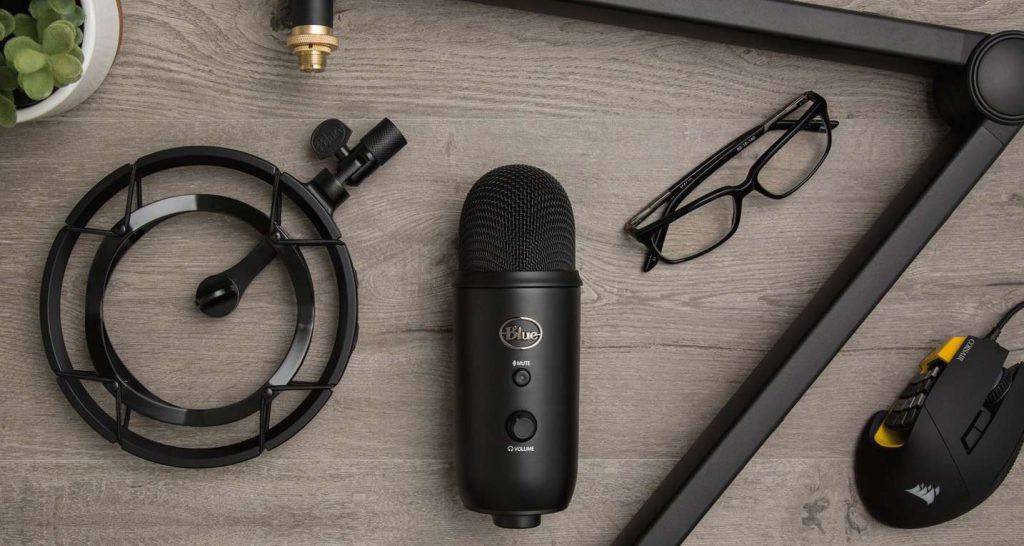This post was originally published on Sound Mind | The Blue Journal on July 25, 2018.
A USB mic connects directly to the USB port on your computer, while an XLR mic requires an external recording interface or a digital I/O.
Neither option is inherently better than the other. In fact, many USB mics use the exact same components as their XLR counterparts, so the sound quality is comparable. However, each type of mic excels in different situations.
In this article, we’ll take a look at the benefits of each configuration to help you find the perfect mic for your streaming rig.

USB MICS
USB mics like the Blue Snowball or Yeti are a leading choice for gamers because they sound great, they’re easy to use and they don’t require any additional gear. Blue Yeti is the best-selling microphone in the world for gamers, and for good reason — Yeti offers streamlined controls and plug-and-play connectivity.
USB mics are ideal for solo-streamers and gamers on-the-go, but if you want to incorporate additional pro audio gear into your set-up like multiple microphones, audio mixers or outboard signal processors, press SELECT and choose an XLR Microphone in the EQUIPMENT window.
The Blue Yeti Pro is perfect for gamers who want both the convenience of recording via USB and the flexibility of recording via XLR. Yeti Pro is the first microphone that captures 24-bit/192kHz digital recordings on your desktop and connects to professional recording equipment in the studio. Whether you record at home, in the studio, or on the go, Yeti Pro offers the best of both worlds.

XLR MICS
If you have the flexibility to incorporate additional pro audio gear into your streaming setup — such as an audio interface, mixer, or outboard gear — then an XLR mic is a great choice. But with more options to choose from than a Mortal Kombat game, it can be overwhelming trying to find the perfect microphone.
From trusty handheld mics, to legendary broadcast mics, to iconic studio condensers — there are countless XLR microphones that can help you improve the sound quality of your streams. But which one is right for you?
Since everyone’s voice is unique, there’s no way to tell which mic will best complement your particular vocal tone without trying it yourself. Ultimately, your decision will depend on a few factors: budget, microphone type and overall sound quality. Start by narrowing down which mic type will work best for your streams.
Dynamic mics like the Shure SM7b or Blue Encore series are great at handling loud noises, so if you’re a screamer or you “tilt” easily, a dynamic microphone can keep you from clipping and creating distortion. On the other hand, condenser mics like the Blue Spark SL or Bluebird SL are capable of capturing more detail and clarity than their dynamic counterparts.
After finding the right mic, it’s time to connect it to your computer. Obviously, there’s no USB cable — but there’s also nowhere on your tower to plug in an XLR cable.
To connect an XLR microphone to your computer, you need an audio interface. Audio interfaces are complex devices that fill two vital roles in the recording process: preamps to amplify the level of the microphone, and digital converters to convert the analog signal from the mic into a digital signal that can be processed by your computer.
Audio interfaces also allow you to capture independent signals from multiple XLR microphones. If you’re planning on hosting any tournaments, LAN parties or couch co-op competitions with multiple players, a USB mic isn’t going to cut it — it’s time to pick up an audio interface and a few XLR microphones.
When it comes time to record, setting up one or more XLR mics is just as easy as recording with a USB mic — simply connect your microphone(s) to the interface using an XLR cable and select the interface as the input source on your streaming platform.

ACCESSORIZE LIKE A PRO
With a high-quality microphone, your streams should sound significantly better — but with a few accessories, you can improve the sound quality of your streams even more!
Compass is a premium broadcast boom arm with internal springs and built-in cable management, ideal for broadcast applications like streaming. With smooth, quiet operation and sophisticated on-camera looks, Compass is sure to elevate the production value of your streams.
Shock mounts like the Radius III, Ringer and S3 are used to isolate microphones from noise, shock and ambient vibration. Designed to work with virtually any microphone or mic clip that has a standard thread mount, shock mounts are the perfect solution for preventing noise from agitating the mic when streaming.
Pop filters like The Pop offer protection from “plosives” or popping sounds caused by bursts of air from “p” and “b” sounds. Plus, as an added bonus, they help prevent spit from getting into the mic during heated moments.
MARIOS VS. LUIGIS
If you’re looking to create a more professional stream, sound quality really separates the Marios from the Luigis. No matter which route you choose, any professional-grade microphone will offer a huge improvement in over your built-in microphone.
Professional sound quality could be the thing that sets your stream apart from the hordes of Lemmings online and catapults you to internet superstardom. And if not, at least your voice will sound great while you’re cursing about lag ;)
For more tips and tricks on taking your streams to the next level, visit Sound Mind | The Blue Journal.